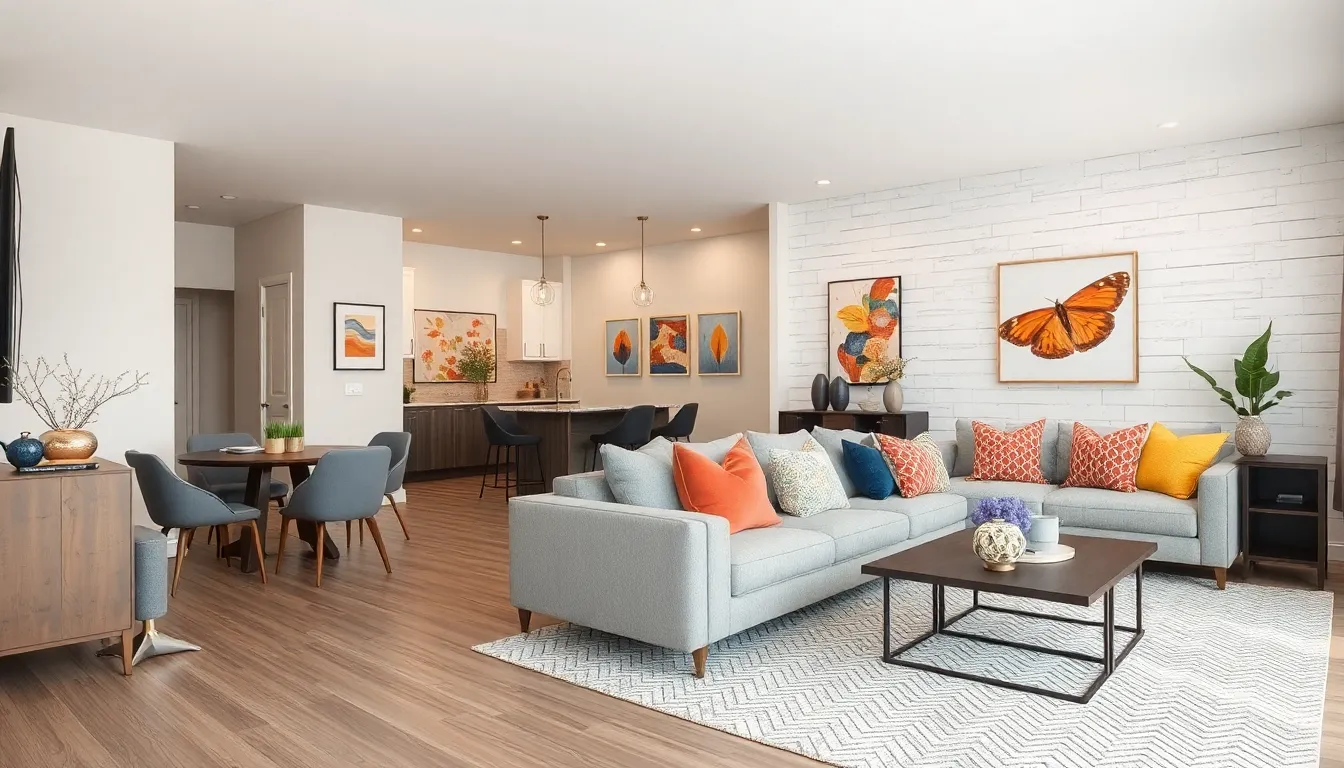Open floor plans have taken the interior design world by storm, transforming how people live and entertain. Gone are the days of cramped rooms where conversations get lost in the walls. Instead, these airy spaces invite creativity and connection, making them perfect for everything from hosting dinner parties to cozy family movie nights. But how does one tackle the challenge of decorating such a vast canvas?
Table of Contents
ToggleUnderstanding Open Floor Plans
Open floor plans blend multiple living areas, creating a seamless flow throughout the space. This design choice revolutionizes how people interact within their homes.
Benefits of Open Floor Plans
Open floor plans encourage social interaction and connectivity. Family members can converse while doing different activities, such as cooking or watching TV. These designs also maximize natural light, enhancing the overall ambiance. Flexibility becomes a significant advantage, allowing homeowners to rearrange furniture easily. Additionally, these layouts often increase the perceived size of a home, making small spaces feel larger.
Challenges of Decorating Open Spaces
Decorating open spaces presents unique challenges. Defining separate areas without physical barriers becomes crucial for functionality and aesthetics. Selecting cohesive color schemes might require extra effort to maintain visual harmony. Moreover, choosing appropriate furniture to fill expansive areas can complicate the design process. Noise can also become a concern, as sounds travel easily throughout the open layout, potentially disrupting the peaceful environment.
Color Schemes for Open Floor Plans

Color schemes play a vital role in enhancing the aesthetics of open floor plans. A well-chosen palette connects spaces while reflecting individual style.
Choosing a Cohesive Palette
Selecting a cohesive palette is essential for an open floor plan. This approach maintains visual harmony across interconnected areas. Neutral shades, such as beige or gray, act as a unifying base. Add color through accents in textiles, artwork, and accessories. Incorporating similar tones across large pieces, like sofas and rugs, further fosters cohesion. When bright colors enter the mix, balance them with subtle hues to prevent overwhelming the space. Consider natural light and existing decor to refine palette choices.
Accent Walls and Focal Points
Creating accent walls serves as an effective way to highlight specific areas in an open floor plan. Use bold colors or unique textures to draw attention to a designated wall. Ideal locations for accent walls include behind the sofa or in dining spaces. Strategically placing artwork or an oversized mirror can enhance these focal points, adding visual interest. Incorporating materials like shiplap or painted brick elevates the design, providing additional depth. Focus on transitioning colors smoothly between spaces to ensure the overall look remains cohesive.
Furniture Arrangement Tips
Effective furniture arrangement plays a crucial role in open floor plan design. Thoughtful placement enhances both aesthetics and functionality.
Defining Spaces with Furniture
To define distinct areas within an open floor plan, strategically position furniture pieces. Use area rugs to delineate spaces; a rug under a dining table creates a clear dining zone. Furniture layout can guide movement; a sectional sofa facing a coffee table encourages conversation. Additionally, consider choosing taller furniture, such as bookcases, to visually separate functional areas without obstructing light. This method facilitates connection while establishing boundaries in shared spaces.
Creating Flow and Functionality
Creating flow between areas requires intentional furniture selection. Opt for versatile pieces that serve multiple purposes, like ottomans or side tables. Maintain clear pathways among furniture; ensure at least 18 inches of walking space around seating areas. Integrating furniture on a diagonal can enhance visual interest and flow. Lastly, incorporate elements like end tables or console tables to bridge different zones while enhancing overall functionality in the layout.
Adding Texture and Layering
Incorporating texture and layering greatly enhances the visual appeal of open floor plans. This approach creates depth and interest, making the space feel inviting.
Textiles to Enhance Comfort
Textiles play a crucial role in bringing warmth to open floor plans. Fabrics, such as velvet and linen, contribute luxurious touches while providing comfort. Layering throw pillows and blankets adds both style and coziness to seating areas. Utilizing various patterns and colors creates a dynamic environment without overwhelming the senses. Incorporating lightweight curtains offers softness and allows natural light to filter through, maintaining an airy feel. When strategically placed, these textiles can also help define spaces and enhance comfort throughout the entire area.
Using Rugs for Zone Definition
Rugs serve as effective tools for defining zones within an open floor plan. Choosing area rugs that complement furniture helps create visually distinct areas for dining, relaxing, or working. Selecting colors and patterns relevant to the overall decor ties different zones together while establishing boundaries. Larger rugs are ideal for anchoring seating arrangements, making spaces feel cohesive. Smaller rugs can delineate narrower paths through the area. Using textures, such as woven or shag, adds additional layers of interest, ensuring each zone maintains its own character while contributing to the overall design.
Incorporating Lighting
Lighting plays a crucial role in enhancing the ambiance of open floor plans. Thoughtful lighting choices can significantly influence the overall feel of interconnected spaces.
Natural Light Considerations
Maximizing natural light benefits all areas of an open floor plan. Large windows and glass doors improve brightness, creating a welcoming atmosphere. Positioning mirrors strategically reflects light, amplifying brightness in darker corners. Use sheer window treatments to allow sunlight while maintaining privacy. Integrating skylights introduces additional daylight, particularly in spaces lacking windows. Prioritize unobstructed views to encourage light flow throughout the home.
Layered Lighting Solutions
Layered lighting adds depth and functionality to expansive areas. Combining ambient lighting with task and accent lighting creates a balanced environment. Overhead fixtures, such as chandeliers or pendant lights, offer general illumination. Table lamps and floor lamps provide targeted light for reading or working. Wall sconces can enhance architectural features while casting a warm glow. Flexibility is key; dimmer switches allow for mood adjustments, catering to various occasions.
Embracing open floor plans can transform a home into a vibrant and dynamic space. By thoughtfully selecting color schemes and furniture arrangements, individuals can create distinct zones while maintaining a cohesive aesthetic. Textures and layering add depth and warmth, making the environment inviting and comfortable.
Lighting plays a pivotal role in enhancing the overall ambiance, ensuring that each area feels connected yet defined. With careful consideration of these elements, anyone can successfully navigate the challenges of decorating open floor plans, ultimately crafting a harmonious living space that fosters connection and creativity.




